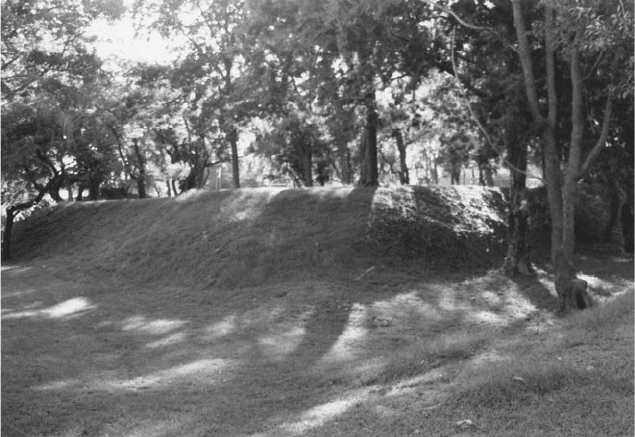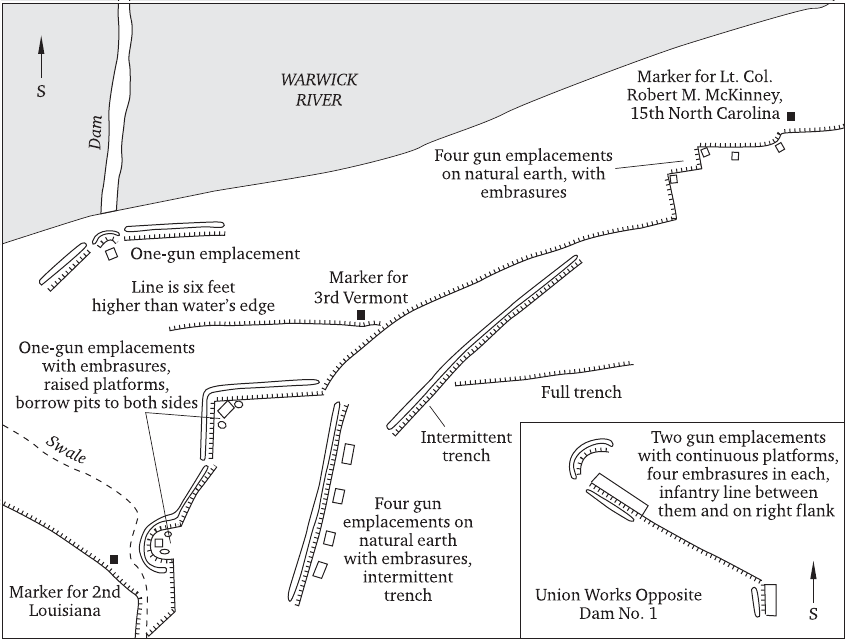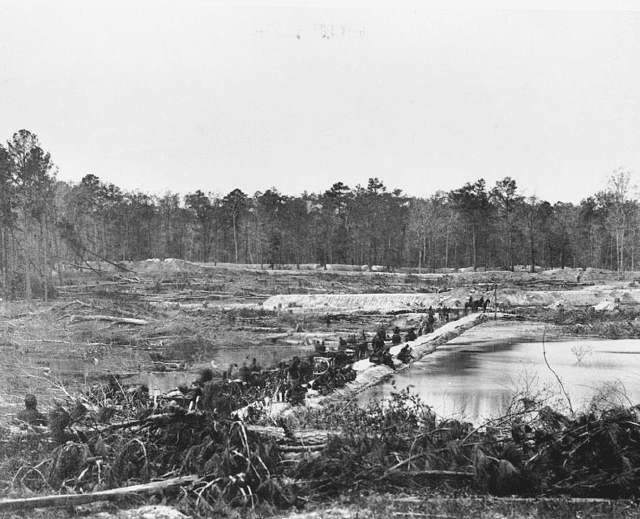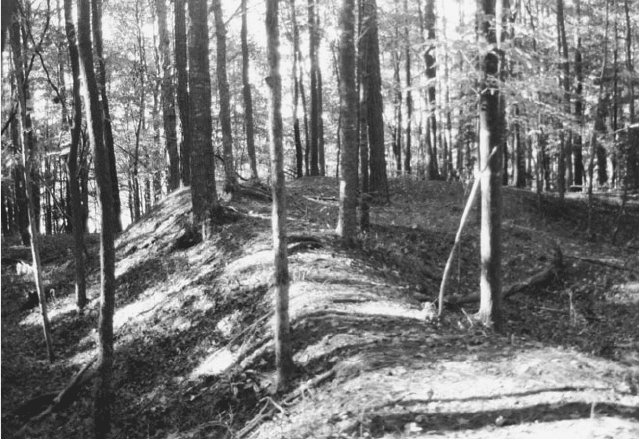Hess Earl J. Field Armies and Fortifications in the Civil War: The Eastern Campaigns, 1861-1864
Подождите немного. Документ загружается.

318 Appendix 1
on the night of April 29, this branch allowed the Federals to observe much of the
area between the Union and Confederate positions.
∑
By the end of the confrontation at Yorktown, engineers and soldiers had run
another line from Redoubt A to Battery No. 5 and had started a line westward from
A toward Batteries No. 7 and 8. Improvements on earlier lines continued even as
new lines were opened. A banquette, made of logs in some sections and earth in
others, was added to them.
∏
At first the Confederates fired very little on the Federals when they dug in
opposite the Warwick Line, but they let loose an 8-inch gun on the diggers who
worked on the line stretching from Battery No. 10 to the York River. Barnard re-
ported that it did not delay the project, but he found it surprising that the Rebels did
not harass his engineers and the infantry more systematically. He also noted that
they failed to fire into the ravines and woods behind the Union position to disrupt
support efforts. Barnard estimated that no more than a dozen Federals were hit by
Confederate artillery fire while working on the fortifications.
π
Although Barnard and everyone else called these lines parallels, they were, in
fact, not like the work traditionally given this term. The concept was initially devel-
oped by French military engineer Sebastien Le Prestre de Vauban in the mid-
seventeenth century. As used by him in many sieges conducted to further the
strategic goals of Louis XIV, they were dug parallel to the enemy’s line of defense
and served as the starting point for all future siege approaches. At Yorktown the
Federals dug them as an afterthought to connect existing batteries. Gillmore’s men
dug genuine parallels on Morris Island, but Barnard’s subordinates erected curtains
to connect enclosed works. The result was a system of fieldworks, dug in different
sections and at different times, that constituted an irregular line.
The Yorktown system of works was the first major entrenchment project con-
ducted by the Army of the Potomac in the field. Inevitably, problems were encoun-
tered. ‘‘There is great difficulty about tools,’’ Fitz John Porter recorded in the ‘‘Jour-
nal of the Siege.’’ The quartermaster department issued them to the troops but
failed to keep accurate records of how many were given to each unit. Infantry
officers neglected to keep track of them, and soldiers often kept them for use in
camp or simply threw them away. This often caused delays for work details. Big
shipments arrived by boat up the York River, and tools for 10,000 men were avail-
able in the depots by April 27; but proper implements came and went with frustrat-
ing uncertainty. Despite the huge quantity of tools issued during the campaign,
Barnard had to rush a new shipment to the army to build the Harrison’s Landing
Line at the end of the Seven Days battles.
∫
Even though McClellan had a large number of engineer officers, Barnard asked
that artillery officers help to design and construct the works. At least eight offi-
Appendix 1 319
cers and several more who served as their assistants were regularly detached from
their units. In addition, the men of two field batteries were sent to the Volunteer
Engineer Brigade for three days of instruction to learn how to make gabions and
fascines.
Ω
Woodbury’s engineers were primarily responsible for constructing thousands of
gabions and fascines needed to shore up parapets and traverses in the growing
system of fieldworks. Not only did they teach the artillerymen how to do this, but
they instructed the 5th New Hampshire and 69th New York as well. From April 17 to
May 4 Woodbury put an average of 283 men per day on this work. They made at
least 2,888 gabions and several hundred fascines. In addition to these wooden
components constructed in the depots to the rear of the line, a total of 113,500
empty sandbags were shipped to McClellan’s army for use as revetment material.
∞≠
A more specialized article was the mantlet, a protective device to cover the
embrasure of a gun to shield the crew from enemy observation and fire. Mantlets
could be lifted when firing, or a circular hole could be cut in them to allow the gun
tube to stick through. McClellan asked for 100 rope mantlets, inspired by their use
on the Russian line at Sebastopol. Col. Richard Delafield, who had been one of the
commissioners on McClellan’s trip to Europe seven years earlier, took the responsi-
bility of making them in New York City. He had difficulty finding the right kind
of rope and thus made only twenty-five. The rest were constructed of half-inch
wrought iron attached to oak planks that were three inches thick. Delafield thought
iron was more effective than rope anyway, as it added a greater degree of protection
against sharpshooters. Both types of mantlets were made in layers; the rope had
three layers to make a total thickness of six inches, and the metal consisted of two
layers of quarter-inch iron. Both types were shipped to the Peninsula. They were
installed in fifteen embrasures of Battery No. 2 on April 29, and three more went to
Battery No. 3 a short time later. By the end of the confrontation at Yorktown, these
were the only artillery emplacements with such protection, but they were never
tested in battle. Barry’s artillerymen were innovative in protecting the gabion revet-
ment of their embrasures, stretching green hides across the woodwork.
∞∞
Labor on the Union system of fortifications intensified as April neared its end.
Merlons of sandbags were built atop the parapet of Redoubt A to create embrasures
for the gunners. A covered way, or protected road, was dug between Batteries No. 7
and 8. Abatis was placed in front of at least some segments of the infantry line.
Redoubt C, one of the more exposed works, received a lot of attention. Its ditch was
widened by successive work details until it was twelve feet wide and six feet deep.
Work continued on all projects until the morning of May 4, when it was discovered
that the Confederates had evacuated the Warwick Line. There was still more work
to be done. Several heavy batteries needed more traverses or thicker parapets,
320 Appendix 1
curtains needed to be completed, and revetting had to be finished in some works.
Redoubt D was only started the night before, and a mortar battery to enfilade the
cluster of Confederate works at Wynn’s Mill was under way.
∞≤
The ordnance for these works was also in place by May 4. A total of 120 pieces (13
heavy, 45 mortars, 44 medium, and 18 field guns) were ready for action. More
than 17,000 projectiles were stockpiled, 33 of which were 30-pounder shells filled
with ‘‘Greek fire.’’ The weight of ordnance was astonishing. Maj. Alexander Doull,
the ordnance officer of McClellan’s siege train, noted that the heaviest gun at
Sebastopol was an English 68-pounder that weighed 10,649 pounds. The 200-
pounder Parrott at Yorktown weighed 16,570 pounds. Doull proudly concluded that
the weight of Federal artillery at Yorktown amounted to 50 percent more metal
than ‘‘any guns that have ever before been placed in siege batteries.’’
∞≥
Barnard and Barry were convinced that they could have pounded the Rebels out
of the Warwick Line with their combination of fieldworks and artillery, but Barnard
was confident that he could have pried them out even with siege approaches if
McClellan had allowed him. There were several ravines that originated between the
lines and drained toward the Federal position. The Rebels could only see imper-
fectly into the heads of these drainage features, and therefore the Yankees could
have worked in them in relative safety. Barnard had already chosen one ravine that
could have allowed his men to dig a sap toward the ditch of the Yorktown city
defenses. Admittedly he could not see this so clearly until the Rebels gave up their
defenses, but Barnard seemed eager to try siege approaches. On the opposite side of
the pending battlefield, Confederate Brig. Gen. Jubal Early thought his part of the
Warwick Line was vulnerable to siege operations. He held the area encompassing
the Red and White redoubts, on the spine of land that was the watershed of the
Peninsula. This high, level ground, he thought, offered a good opportunity for siege
approaches.
∞∂
Confederate Works: The Warwick Line
All along the Warwick River, from Yorktown to Mulberry Island, the Confeder-
ates transformed a meager line of works into one of the more impressive field fortifi-
cations of the war. It intimidated McClellan into a month-long digging competition.
The defenses around Yorktown were a citadel, a self-contained work inside a
larger fortification; they were extensive, heavy, and studded with large guns. The
line enclosed Yorktown on three sides, with the heaviest parapets and ordnance
located on the south facing the Yankees. The parapet was 15 feet thick with a ditch
up to 10 feet deep. Barnard thought these southward-facing works were the oldest
of the Warwick Line. The works that circled west and north of town had probably
been constructed the preceding winter, he guessed. They had equally thick para-
pets and deep ditches. In addition to these city defenses, there were seven water
Appendix 1 321
batteries to impede river traffic. These had parapets 18 feet thick with ditches 10
feet deep and were located about 80 feet above the water level. Sod covered the
parapets of the water batteries, while sandbags and cotton bales were used to build
traverses and embrasures in all the works around town. Most of the revetting con-
sisted of log-and-post construction. The water batteries were armed with twenty-
three guns, mostly 8-inch Columbiads and 32-pounders. Most of these works were
located exactly where the British had built their own defensive works in 1781.
∞∑
Supporting the Yorktown city works were the defenses across the river at
Gloucester Point. The York River is 1,000 yards wide at this point and demands a
heavy work mounting sufficient guns to command the tidal stream. The Confeder-
ates constructed a water battery mounting twelve heavy guns. Shaped like a U, with
its rear enclosed, it was barely 2 feet above high tide and had parapets 20 feet thick
and nearly 8 feet high on the interior. Like the water batteries across the river, the
parapet was protected by a layer of sod, and the embrasures were made of stacked
layers of turf. A much larger fieldwork was constructed on the bluff, 40 feet above
the water, to the rear of the water battery. Its parapet was also 20 feet thick and 7 to
10 feet high, with a ditch that ranged from 7 to 15 feet deep. This large fort had
several bombproofs in the center for the protection of the garrison and a layer of
sod on the parapet, but it only mounted three guns in barbette positions. The water
battery was the main defense against Union ships; the huge fort to the rear was
built for its protection.
∞∏
Stretching westward from Yorktown, the Warwick Line first took advantage of a
short stream called Beaverdam Creek that flows into the York River just north of
town. Then it crossed the spine of the Peninsula, which was a few feet higher than
the land to either side, along which the major road to Richmond was laid. This was
the most favorable ground for a Union advance, and the Rebels had no natural
obstacles to help them. Two heavy redoubts were constructed, called by Federal
observers the White and Red Redoubts. The former, also known as Fort Magruder,
was an enclosed work 850 yards from Yorktown. It was shaped like an arrowhead
that pointed west, and the connecting infantry line was attached to its front face.
Fort Magruder had a stockade to cover its rear and mounted a 9-inch Dahlgren, a
4.5-inch rifle, and an 8-inch howitzer. With emplacements for field guns, the fort
had room for twenty-two artillery pieces. Two embrasures were protected by mant-
lets. There were also emplacements for a few guns along the curtain connecting
Fort Magruder to the Yorktown city defenses. Fort Magruder was an older work,
constructed, Barnard reasoned from the settling and erosion, during the preced-
ing winter.
The Red Redoubt, 525 yards west of the White Redoubt, was square, and the
connecting infantry line was also attached to its front face. Barnard thought the fort
started as a section of the curtain and then additional faces were added to make an

322 Appendix 1
Remnants of Confederate fort, Gloucester Point, Yorktown campaign. This is a portion
of the large star fort that protected the water battery. The view shows a part of the east
face, pointing away from the water battery and toward an inland approach. (Earl J.
Hess)
enclosed work. It was not as strong as Fort Magruder. The guns were mounted en
barbette, and Federal observers from Battery No. 13 could see into its interior. To
strengthen this area, the Confederates built a secondary line of infantry trench to
the rear of both forts and dug five communication trenches to connect both lines.
The communication trenches had to be dug in a zigzag configuration because the
land gradually sloped up from the Confederate front line to the rear, exposing the
rear areas to Union artillery fire. Barnard was not impressed with this arrangement
and noted that these infantry works were not well placed to allow soldiers to fire
from them.
∞π
From the White and Red Redoubts the Warwick Line ran to the upper reaches of
the Warwick River and followed that stream all the way across the Peninsula.
Wynn’s Mill, about 3,000 yards west of the Red Redoubt, was one of the most
heavily fortified points on the line because the river bends in a right angle, neces-
sitating extensive works to protect against enfilade fire. The complex of works at
Wynn’s Mill is 650 yards wide and about 100 yards deep. The first line curves to stay
within 10 to 20 yards of the water’s edge. It contains thirty-five traverses designed
to protect both artillery and infantry positions. These traverses vary in size and

Appendix 1 323
N
To redoubt
Thirty-five traverses,
nine do not connect to trench
Ditch in front
of artillery
emplacements
Detail of
bombproof
Detail of junction
of communication
trench and main line
Communication
trench
Communication
trench
Communication
trench
Sally port
C
o
v
e
r
e
d
w
a
y
C
o
v
e
r
e
d
w
a
y
C
o
ve
r
e
d
w
a
y
Confederate Works at Wynn’s Mill, Warwick Line, Yorktown, April 1862 (based on field
visit, 1995; OR Atlas, pl. 19, no. 29; and ‘‘Map of Yorktown and Vicinity,’’ YB)
length, but most are either 10, 15, or 20 yards long. Some have dirt dug on only one
side, while a minority are dug on both sides to make a wide, thick bank of earth.
Ditching exists only in front of artillery positions, not infantry posts, to make a
thicker parapet to resist counter battery fire. Wynn’s Mill has five artillery positions
with a total of eight gun emplacements. Most of the emplacements have raised

Confederate Works at Dam No. 1, Garrow’s Point, Warwick Line, Yorktown, April 1862 (based on field visit, 1995)
Appendix 1 325
platforms to lift the guns a few inches above the natural level of earth. Two em-
placements are in bastions, which enabled the Rebels to construct two embrasures
for one gun position, allowing for a greater degree of lateral aiming.
A system of covered ways and communication trenches connects the main line
to a large redoubt northwest of the angle. It was located to the rear of the main line.
These covered ways have a good bank of earth on the side facing the enemy, while
three smaller communication trenches that branch out from them at different
points have dirt banked on both sides. Two of the covered ways have zigzag seg-
ments at their ends because they approach the Union positions across the river
head-on. Each zig and zag is about six yards long. Two of the communication
trenches also have zigzag configurations. One of the communication trenches joins
the main line with a bit of natural earth left at the junction to shield men in the
communication trench from enemy fire down its length. An oddly shaped bomb-
proof, consisting of a sharply curved parapet that literally wraps around to provide
shelter on three sides, exists on one of the covered ways.
∞∫
Despite the danger of enfilade fire at this angle of the Warwick Line, the Confed-
erate position at Wynn’s Mill would have been very difficult to reduce. The next
strongpoint downriver was Dam No. 1 at Garrow’s Point, about six miles from
Yorktown. While a bit smaller than Wynn’s Mill, it was a formidable position. The
natural width of the Warwick at this point was 15 feet, but the dam turned it into a
lake 100 yards wide. The outlet for drainage of excess water was located on the
Confederate end of the dam. Trees were cut for about 75 yards in all directions from
the dam, whose top was wide enough for artillery and wagons to cross the river.
The works were built in layers. The first is a short line protecting an emplace-
ment for one gun 20 yards from the water’s edge and aimed along the length of the
dam. The second layer is the main line of defense, a portion of the continuous line
that links with Wynn’s Mill to the left and the other positions to the right. It ranges
from 40 to 150 yards from the water’s edge and lacks traverses. The line makes
several sharp turns and contains six artillery emplacements, four of which are
located in angles and one in a bastion. All of these emplacements have embrasures;
some of them also have raised platforms, while in others the guns rested on the
natural level of the earth. Two gun positions have borrow pits to both sides, as the
gunners needed extra dirt to strengthen the parapet or raise the gun platform, and
two gun positions have a good ditch in front as well.
In addition to these artillery emplacements along the main line, the Confeder-
ates built a four-gun artillery position immediately to the rear. It consists of a single,
large parapet with a good ditch and an irregular trench between the gun emplace-
ments. The latter was dug simply to obtain more dirt to strengthen the parapet,
which is fifteen feet wide at the base. The gun positions have embrasures and
platforms at the natural level of the earth but lack traverses. The entire four-gun

326 Appendix 1
Confederate Dam No. 1, Garrow’s Point, Yorktown. Taken by photographer H. G.
Houghton of Brattleboro, Vermont, this rare view shows Battery F, 5th U.S. Artillery,
crossing the Confederate dam. The regular unit was one of four batteries attached to
the Second Division, Sixth Corps. In the distance one can see the one-gun emplacement
close to the Confederate end of the dam, and the main line behind it. The four-gun
emplacement behind the main line is visible because of its pronounced embrasures. All
of these works are well preserved today. (Vermont Historical Society)
position aims to the left oblique and supports the main line as it refuses several
yards away from the river to cross a wide swale. After crossing, the main line
returns toward the river.
To the rear of the four-gun position, and the main line as well, are two short,
supporting trenches that constitute a third layer of defense. These are for infantry
only, and one appears to have been started but abandoned in favor of the second.
The first has a ditch and intermittent trench that stretches for only two-thirds of its
length. The second short line has no ditch but a very good trench and a better
parapet than the first. The second line also is positioned more effectively to support
the main line.
The works that lay to the left and right of the position at Dam No. 1 were also
strong. Between Garrow’s Point and Wynn’s Mill is a fully excavated artillery posi-

Appendix 1 327
Remnants of Confederate one-gun emplacement, Dam No. 1, Yorktown. This photo
shows the one-gun emplacement in the angled salient on the main line. (Earl J. Hess)
tion. The Confederates dug a rectangular space 3 feet deep, 15 yards wide, and 5
yards to the rear. It is 125 yards from the water’s edge and has three embrasures,
two facing the river and one facing to the right. Immediately to the left of this
position they also dug two more artillery positions for one gun each, with embra-
sures pointing straight ahead.
Substantial remnants of the Confederate fortifications allow us to glimpse the
nature of the works between Dam No. 1 and Lee’s Mill, which lay three miles from
Garrow’s Point. The main line between these two locations approaches the water in
some spots and lies 150 yards away in others. The Confederates were aware that
they needed to allow water to drain through swales toward the river when it rained,
and they altered their works to accommodate that need. Across a swale just to the
right of the complex at Dam No. 1 they left a 6-yard-long gap in the main line and
built a short traverse 10 yards from the gap for flank protection. As we have seen,
the Rebels refused their line to cross the swale just to the left of Dam No. 1 as well,
and they built artillery emplacements to fire obliquely across the swale in case the
enemy chose to test this returned section of trench. They did similar things to the
right of Dam No. 1. Two artillery emplacements exist in well-preserved form on
both sides of a swale. Both are built in a shallow V so guns could fire forward across
the river and obliquely across the swale. They have embrasures and a large, strong
parapet.
∞Ω
